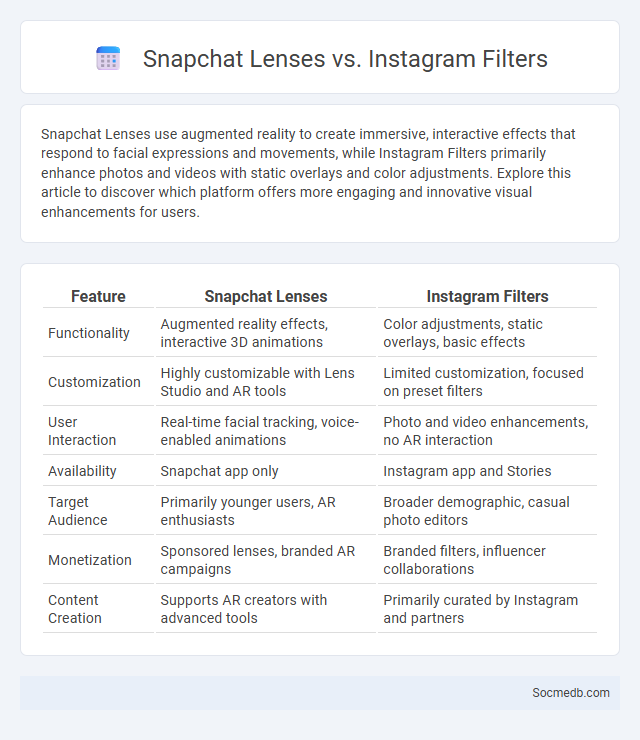
Photo illustration: Snapchat Lenses vs Instagram Filters
Snapchat Lenses use augmented reality to create immersive, interactive effects that respond to facial expressions and movements, while Instagram Filters primarily enhance photos and videos with static overlays and color adjustments. Explore this article to discover which platform offers more engaging and innovative visual enhancements for users.
Table of Comparison
| Feature | Snapchat Lenses | Instagram Filters |
|---|---|---|
| Functionality | Augmented reality effects, interactive 3D animations | Color adjustments, static overlays, basic effects |
| Customization | Highly customizable with Lens Studio and AR tools | Limited customization, focused on preset filters |
| User Interaction | Real-time facial tracking, voice-enabled animations | Photo and video enhancements, no AR interaction |
| Availability | Snapchat app only | Instagram app and Stories |
| Target Audience | Primarily younger users, AR enthusiasts | Broader demographic, casual photo editors |
| Monetization | Sponsored lenses, branded AR campaigns | Branded filters, influencer collaborations |
| Content Creation | Supports AR creators with advanced tools | Primarily curated by Instagram and partners |
Introduction to Augmented Reality Filters
Augmented reality (AR) filters on social media platforms enhance user experience by overlaying digital effects onto real-world images and videos. These interactive filters use computer vision and facial recognition technology to create immersive and personalized content, boosting engagement and creativity. Your social media presence can significantly benefit from incorporating AR filters to captivate and connect with your audience in innovative ways.
Snapchat Lenses: Features and Innovations
Snapchat Lenses utilize augmented reality technology to create immersive, interactive experiences by overlaying digital effects onto users' faces and surroundings. Features such as face tracking, 3D depth sensing, and real-time facial recognition enable dynamic animations, filters, and gamified elements that adapt to user expressions and movements. Continuous innovations, including AR multiplayer capabilities and AI-powered customization, maintain Snapchat's competitive edge in social media by enhancing user engagement and creative content sharing.
Instagram Filters: Functionality and Styles
Instagram filters enhance your photos by adjusting colors, contrast, and brightness to create visually appealing images that align with various moods and aesthetics. Popular filter styles range from vintage sepia tones to vibrant, high-contrast looks, enabling personalized content that boosts engagement. Using Instagram filters effectively can transform ordinary snapshots into eye-catching visuals that attract more followers and increase your social media presence.
Instagram Lenses: Expanding the AR Experience
Instagram Lenses transform your social media interaction by blending augmented reality (AR) with everyday sharing, allowing users to create immersive visual content that captivates followers. These AR filters enhance engagement through dynamic effects, interactive animations, and contextual overlays, making stories and posts more compelling and personalized. As Instagram continually updates its Lens technology, your content can stay ahead in creativity, driving higher visibility and user interaction on the platform.
User Engagement: Snapchat vs Instagram
Snapchat's ephemeral content and interactive features like AR lenses drive higher engagement among younger users, fostering real-time communication and creativity. Instagram's diverse content formats, including Stories, Reels, and Shopping, boost user interaction through visual appeal and seamless integration with e-commerce. Both platforms leverage personalized algorithms to increase time spent and content discovery, but Instagram generally achieves broader demographic reach and sustained engagement levels.
Customization and Creation Tools Compared
Social media platforms offer diverse customization and creation tools that empower you to tailor content and enhance engagement. Features such as Instagram's Stories stickers and TikTok's video editing effects provide intuitive options for personalized content creation. These tools enable users to express individuality while optimizing posts for maximum visibility and interaction.
Popularity and Trend Analysis
Social media platforms like Instagram, TikTok, and Twitter continuously evolve based on user engagement metrics and viral content patterns, reflecting real-time popularity shifts. Trend analysis tools utilize hashtag tracking, sentiment analysis, and influencer impact to predict emerging content themes and audience interests. Your ability to leverage these insights can significantly enhance brand visibility and marketing strategy effectiveness.
Brand Marketing Opportunities
Social media offers vast brand marketing opportunities by enabling direct engagement with your target audience through personalized content and interactive campaigns. Platforms like Instagram, Facebook, and LinkedIn provide advanced analytics tools to track customer behavior and optimize marketing strategies for increased brand visibility and loyalty. Utilizing influencer partnerships and user-generated content further amplifies your brand's reach and credibility in the competitive digital landscape.
Privacy and User Data Considerations
Social media platforms continuously collect vast amounts of user data, making privacy protection a critical concern. Implementing robust encryption, transparent data policies, and user control over personal information can mitigate risks related to data breaches and unauthorized access. Prioritizing privacy safeguards enhances user trust and compliance with regulations like GDPR and CCPA.
Future of AR Filters and Lenses
The future of AR filters and lenses in social media promises immersive and personalized user experiences powered by advancements in artificial intelligence and computer vision. Brands and content creators can leverage these evolving technologies to drive engagement, offering interactive virtual try-ons, gamified elements, and location-based augmented reality effects. Your social media strategy will benefit significantly by integrating these innovative AR tools to captivate audiences and enhance visual storytelling.
 socmedb.com
socmedb.com